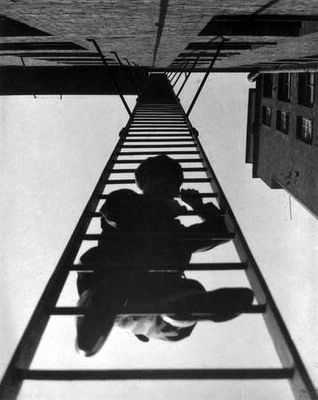O SÉCULO PRODIGIOSO
Rodchenko, Alexander - Fotografia

Rodchenko and Stepanova, 1922

Pro eto. Ei i mne by Vladimir Mayakovsky. 1923
Book with nine letterpress photomontages

Portrait of mother - 1924

Lily Brik - 1924

The poet Vladimir Mayakovsky - 1924

The Critic Osip Brik - 1924

Stepanova with a cigarette - 1924

Vladimir Mayakovsky, 1924

Balconies - 1925

Balconies. 1925

House on Myasnicka Street, 1925

Fire-escape, from the series “House on Myasnitskaya” - 1925

Back cover of the book Conversation with the Finance Inspector
about Poetry (Razgovor c fininspektorom o poesii), by Vladimir
Mayakovsky, 1926

Change of All - 1927

A Part of Moscow, 1927

On the telephone - 1928

Pioneer, 1928

Gathering for the demonstration in the courtyard of the VChUTEMAS
(Higher Institute of Technics and Art) - 1928

To the demonstration - 1928

Pioneer - 1930

Stairway, 1930

Untitled photograph from a series on a lumber mill in Vakhtan. 1930

Lefortovo-Student Village, 1930

Chauffeur - 1933

Belomorkanal Work in the rhythm of orchestra, 1933

Working with an orchestra - 1933

Untitled photograph of a guard and prisoners during the building of the
White Sea-Baltic Sea Canal, 1933

Girl with a Leica - 1934

An Oath. 1935

The live badge - 1936

Varvara Stepanova, 1936
Alexander Rodchenko é um dos máximos expoentes da vanguarda soviética dos anos 30. Nasceu em São Petersburgo, em 1891. A sua familia mudou-se para Kazán, no Oeste de Rússia, onde Alexander estudou Historia da Arte. Posteriormente foi para Moscovo, onde continuou o seu estudo de arte. É, nesta altura, em 1915, influenciado por Malevich, que começou a pintar, com uma tendência abstracta. Alexander Rodchenko é um dos artistas russos mais versáteis dos anos 20 e 30. Como outros muitos artistas dessa época de fervor artístico, experimentou com diferentes técnicas de expressão artística, estudando a pintura, a fotomontagem e a fotografia em profundidade, com o fim de obter imagens sempre inovadoras. Rodchenko representa uma figura muito importante no panorama das vanguardas artísticas e suas imagens tem contribuído para a difusão de Construtivismo Soviético. Faleceu em 1956
.........................................................................................................
Born November 23, 1891, in St. Petersburg, Rodchenko died on December 3, 1956. He attended the School of Arts in Kazan, Russia, from 1910 to 1914, then studied graphic arts at the School of Applied Arts in Moscow (1915). The artist was influenced by the Futurists, Cubism and Art Nouveau, and his mentor was Vladimir Tatlin. Rodchenko's first job was as an assistant to Tatlin at a 1916 Futurist exhibit in Moscow, at which ten of Rodchenko's pictures were shown. In 1918 Rodchenko helped found the Museum of Artistic Culture and became its first director. By 1920 he was one of the most active members of the Institut Khudozhestvennoy Kultury - also known is Inkhuk - and he taught a Vkhutemas (High-Grade Art - Technical Workshops). Beginning in 1918 he was active for several years with the Committee of Applied Arts, a government agency. In 1921-22 he did illustrative work in theater, films, typography and advertising, and continued throughout the 1920s to provide cover designs for a remarkably wide range of publications - from the poet Mayakovsky's books (1925-29) to scientific and technical literature for Moscow publishers. He also designed the cover of Kino-Fot, a periodical of the Russian Constructivists which began in 1922 and in which Rodchenko was regularly published. He took up photography in 1924 and gave a short series of talks on the medium at Vkutein (Fine Arts Technical School) in the early 1920's. From 1920 to 1930 he taught at the newly organized Free Public Art Studio (formerly his alma mater, Stroganov School of Applied Arts), where he also served as dean of the faculty of metal-work. Rodchenko began photo-reporting in 1926, working for the magazines Ogonok, Radioslushatel, Prozhektor, Krasnoye Studenchestvo, Dayosh, Za rubezhom, Smena, Borba klassov and the daily Vechernaya Moskva, among others. In 1932 the photographer, whose work was - and still is - widely exhibited, began working in photomontage. During his first and only trip abroad Rodchenko was awarded four silver medals at the Paris Exhibition of March 1925. Also involved in the film world, Rodchenko shot a newsreel series directed by Dziga Vertov, originally called Kino-Pravda and later called One-sixth of the World, which was begun in 1922. Between 1927 and 1930 he was "constructor-artist" of the films The Woman Journalist, Moscow in October, Albidum, The Puppet Millionaire and What Shall I be?. He also directed the documentary The Chemicalization of the Forest. Seemingly unlimited in his versatility, Rodchenko was also involved in theater, designing the costumes and props for Glebov's Pendulum and The Bed Bug in 1929, and was one of Russia's foremost painters, collagists and poster artists. A Constructivist, Rodchenko was one of the earliest photo-collagists. Some of his favorite themes were sports, the circus, festive processions and the Soviet way of life. He successfully experimented with close-up photography, and "the lens of his camera discovered objects of unusual architecture, rhythm, and plasticity" in objects removed from their usual surroundings. "The viewer who sees only a study in the picture of the glass jug illuminated from behind fails to appreciate the masterly composition, the noble purity of the lines, the rich plasticity of the form and consequently also the poetry and beauty of the picture, and still more important, its specifically photographic qualities"
(Karginov, Rodchenko).
...........................................................................................................
.
Sem comentários:
Enviar um comentário